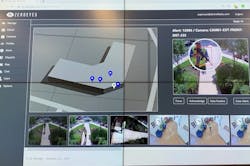How Surveillance Systems Detect Weapons in Real-time
There is a vast infrastructure of security cameras in the world. They are primarily used as forensic evidence. Cameras feeds are only scrutinized after there is an event. Why is something vandalized? Why is something missing? What truly happened in this confrontation? Who was at fault in this altercation? Video footage is often sought after by divorce lawyers trying to corroborate evidence to win in court, or by law enforcement in order to bring up charges.
While this information can truly be valuable, it is missing two incredibly important features. These features are real-time alerting and behavior modification.
What if the video cameras actually changed behavior because we knew someone was watching them? It turns out that no one ever watches a video camera. We all have heard of “big data” as a buzzword. The trick is what do we do with big data. Is it too much information for us to process? Can we learn anything from big data? Can we leverage the existing information in this world?
This is where we can use computers to help us. What if the video cameras were being watched by a well-defined artificial intelligence?
In our use case, camera feeds are “monitored” by an algorithm that is looking for guns. These guns have to be exposed. If the algorithm “sees” a gun, then an alert is dispatched. The algorithm needs processing power to search every frame in real-time. This requires the use of graphics processing units (GPUs) similar to computer games. Effectively, every camera could be searching in real-time for guns. Alerts could be dispatched in real-time. This means that cameras could become a proactive tool, rather than an after the fact way of placing blame.
As our jobs and world becomes a place of task saturation, we can use machines to take away unenviable or monotonous tasks. This is a perfect use case of so-called artificial intelligence. This is a task that is very simple in concept, but very difficult in practice. A human would get tired or bored very quickly. Machines can do these simple, well-defined tasks easily. Essentially, a computer is watching every single video stream as if a person were watching, solely dedicated to the task. There is no need to add additional headcount to watching video monitors. When an important event occurs in real-time, an alerting method draws attention where it is needed most.
We don’t need to turn our everyday lives into a prison to feel safe
We don’t need to stand in line at TSA or pass through metal detectors every place that we go. These cameras and this infrastructure already exist. No additional data storage is required because the processing is being done in real-time. This is a passive system to make us safer. The information that is used will give authorities an incredible advantage. It is simply a tool. The actions taken are not by a machine. The information is to provide first responders with information at first sight, not first shot. Further, this information is not to be sold or used in any additional manner.
The most important aspect of a system like one from ZeroEyes is we can tap the security team on the shoulder and tell them they need to be at a certain location at a certain time. This can be done by using a map of the detection. The alert will ultimately give key pieces of information, an image of the shooter and the location of the shooter. The image will relay the threat level instantly. The first responders will know the type of weapon or level of threat, they will know what they look like, even if they were to discard the weapon and they will be able to go directly to this threat.
Once that initial alert is relayed to the first responder, they have the opportunity to take a large tactical advantage. The first responders will have an opportunity to isolate and contain a threat before a shot is ever fired. They will have a tactical advantage before there is utter chaos.
These alerts will be used in an easy to understand method and we will use the tool during drills. The image and location give an incredible advantage, but it still just remains a tool in the first responders’ tool belt. The more iterations that they see, the better they can take advantage of the situation. A system like this can be implemented in entire cities. For example, ZeroEyes has a tool that can help to prevent gun violence in a real way.
When law enforcement partners with an artificial intelligence-powered surveillance algorithm, we can mitigate risk without intruding upon the lives of people. Surveillance software can protect patrons in malls, schools, government buildings, or general public spaces. The system can increase safety and security leveraging the existing infrastructure. Software, like that of ZeroEyes, can be the start of a new “fire alarm” against exposed guns.



![Let 01 Cover0920 Digital Edition 5f4daeb1086a7[1] Let 01 Cover0920 Digital Edition 5f4daeb1086a7[1]](https://img.officer.com/files/base/cygnus/ofcr/image/2020/09/LET_01_Cover0920Digital_edition.5f4daeb1086a7_1_.5f5b81a5e15cd.png?auto=format,compress&fit=&q=45&h=139&height=139&w=250&width=250)